#once upon a time in anatolia
Text







"Well, as the poet said. Still the years will pass... and not a trace will remain of me. Darkness and cold will enfold my weary soul."
Once Upon a Time in Anatolia (2011) dir. Nuri Bilge Ceylan
#once upon a time in anatolia#filmedit#filmgifs#moviegifs#fyeahmovies#gifs#dailyfilmsource#dailyflicks#nuri bilge ceylan#muhammet uzuner#mygifs#2011
115 notes
·
View notes
Text





Bir Zamanlar Anadolu'da, 2011
#crime#drama#thriller#bir zamanlar anadolu'da#once upon a time in anatolia#nuri bilge ceylan#ebru ceylan#ercan kesal#muhammet uzuner#tale
11 notes
·
View notes
Text

Once Upon a Time in Anatolia (2011) Nuri Bilge Ceylan
9 notes
·
View notes
Text

Nuri Bilge Ceylan
Bir Zamanlar Anadolu'da
4 notes
·
View notes
Text
movie recommendations nobody wants part 1 :
There Will Be Blood (2007) Dir: Paul Thomas Anderson. Description: A character study into a man consumed by greed in the early 20th century California oil boom
Inside Llewyn Davis (2013) Dir: Joel Coen + Ethan Coen. Description: A folk singer battles depression and poverty over the course of about a week in his life
City of God (2002) Dir: Fernando Meirelles + Katia Lund. Description: A coming of age tale set in the backdrop of one of the most dangerous and violent slums in Rio de Janeiro
Porco Rosso (1992) Dir: Hayao Miyazaki. Description: A pilot is turned into a pig and has turned to bounty hunting during the early days of aviation
Hot Fuzz (2007) Dir: Edgar Wright. Description: Two cops in a small English village must solve a series of seemingly accidental and bizarre deaths
Persepolis (2007) Dir: Vincent Paronnaud + Marjane Satrapi. Description: The real life story of Marjane Satrapi's childhood and family during the Iranian revolution and her schooling in Europe
Song of the Sea (2014) Dir: Tomm Moore. Description: A modern Irish folktale about a young boy, his sister, and his dog's quest to heal the grief of their father
The Worst Person in The World (2021) Dir: Joachim Trier. Description: a few chapters in the life of Julie a young woman whos is on a path to discover who she is
Good Time (2017) Dir: Josh Safdie + Benny Safdie. Description: after a bank heist gone wrong a new york con artist must find a way to bail out his mentally handicapped brother from jail
The Lighthouse (2019) Dir: Robert Eggers. Description: Two men are trapped on a lighthouse isolated from the rest of the world during the mid 1800s
Once Upon a Time in Anatolia (2011) Dir: Nuri Bilge Ceylan. Description: a deep dive into morality and life philosophy told by several cops, a doctor, a prosecutor, and two murders
Kill Bill Vol.1 (2003) Dir: Quentin Tarantino. Description: a woman awakes from a comma to partake in a violent and gory revenge quest against those who wronged her
#movies#film#movie rec list#there will be blood#paul thomas anderson#inside llewyn davis#coen brothers#city of god#porco rosso#hayao miyazaki#hot fuzz#edgar wright#persepolis#song of the sea#the worst person in the world#good time movie#the lighthouse#rob pattinson#the safdie brothers#once upon a time in anatolia#kill bill#kino#bobathansexhaver
8 notes
·
View notes
Photo







İğdebeli'ne yağmur yağıyor.. Yağsın! Yüz yıllardır yağıyor. Ne fark eder? Fakat bundan sadece yüz yıl sonra bile Arap; ne sen, ne ben, ne savcı, ne komser. Hani şairin dediği gibi: "Yine yıllar geçecek ve geride benden bir iz kalmayacak. Yorgun ruhumu karanlık ve soğuk kuşatacak."
17 notes
·
View notes
Text

Seen in 2024:
Once Upon a Time in Anatolia (Nuri Bilge Ceylan), 2011
1 note
·
View note
Text
The most sympathetic movie about police work ever made. —Margaret Yang
0 notes
Text

Films of 2022: Intregalde (dir. Radu Muntean)
Grade: C+

#films of 2022#ok…??#what if the once upon a time in Anatolia roadside stop was an entire movie#intregalde#nothing good ever happens in Romania: part 4576
1 note
·
View note
Photo







Bir Zamanlar Anadolu'da, 2011
#crime#drama#bir zamanlar anadolu'da#once upon a time in anatolia#nuri bilge ceylan#ebru ceylan#ercan kesal#nihan okutucu#fatih ereli#muhammet uzuner#firat tanis#responsibility
17 notes
·
View notes
Text
That Which You Are Fighting For
Stray Gods is a story about change. It's a story about choices and consequences. And overwhelmingly at the start of the musical, the consequences are very clearly bad.
But this is also a story about family. About repairing relationships that have gone horribly wrong, or at least setting them on a less self-destructive path. The early songs establish what could happen when these relationships fall too far. And as a result, there is a sense of directionlessness. You know what you are running away from, but not what you are running towards.
Enter Asterion and Hecate, and the joyful disaster that is You Cast A Spell On Me. It's fun, it's awfully sung on purpose, and it is heartwarming, if you play your cards right. This song proves that there is a hope for the idols.
Let me explain.
SPOILERS AHEAD

Cast A Spell is not eloquent or well sung. I need to get this out of the way because it is one this song's chief criticisms. The reason I want to address this is because this isn't a flaw, this is the entire point of the song. Yes, the song isn't going to be played at any karaoke parties, but a song's worth isn't limited to how well you can sing along to it.
First up, lets break down what this song is doing. This song is about a whirlwind romance between two nerds, and that isn't an obvious decision for the writers to make. The minotaur and the goddess of fate. Why these two?

I said that Stray Gods is about family, and so it draws upon myths with that theme in mind. The Minotaur is part of that. Possibly an original way of rationalising earthquakes (According to Matt Kaplain's Science Of Monsters, published in 2012), the minotaur's story picked up its most iconic form from the Roman Poet Ovid, a man known for having some strong views on authority. The story is very likely to have predated Ovid, but other than artwork, which is notoriously difficult to quote, Ovid is the earliest source I could find (If you have an earlier one, please let me know).
In any case, the story goes that king Minos of Crete prayed to Poseidon for a beautiful bull to consolidate his power as king, in exchange he would sacrifice the bull to Poseidon. Poseidon agreed, but when the time came for the bull to be sacrificed, Minos bailed on the deal. This lead to Poseidon conspiring with Aphrodite to make Minos' wife, Pasiphae, to fall in love with the bull. I will skip the next part of this, to keep things PG. But the footage refocuses, and Pasiphae has given birth to a son, named Asterion, that's our minotaur. This minotaur, however, has a penchant for eating people, so Minos imprisons it in the labyrinth and sacrifices people to it once every few years.
You still following me?
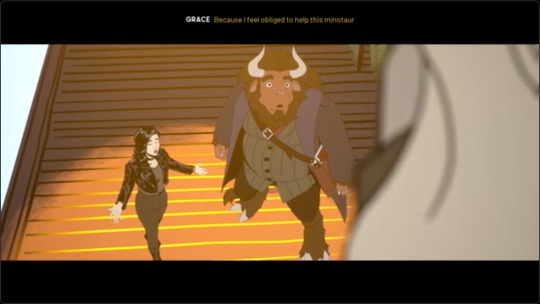
So the minotaur is a child of a truly weird and messed up family, and with the Stray Gods decision to skip over the cannibalisation bit (with the exception of notorious bell-end Theseus), it becomes a family who cast him into the labyrinth for no fault of his own. That theme of messed up family dynamics is here in full swing.

Hecate doesn't have a concrete origine, in mythology or in history. There are theories that she was originally an epithet (regional form) of Artemis, although this doesn't really hold up, and there are theories that she originated in Egypt or Anatolia. It is unclear, and that fits for a goddess of magic and mystery.
She is also sometimes represented as one of three goddesses, according to Pausanias this is because of a sculpture that is now absent, but it's a visual that has stuck around. It's why she has those three faces on the front of her outfit.
Another thing to note are that Wikipedia notes her as a household deity alongside Zeus and Apollo, although the citation for this is dubious, so I would advise taking this with a grain of salt.

In any case, Hecate is mysterious, at least in our modern age. Compare that to the Minotaur, which is iconic, and you have a unique pairing. This is what I am getting at. These two are so incredibly different from each other, in a romance that is so storybook it is bordering on cliche, that it contrasts with the rest of the story. If you can help these two get their happy ever after, what can you do for the rest of the cast?

Next, let's talk about the lyric writing and the singing. Because in my opinion, they are terrible, and I love that. This is a world where you can magically make people start singing, and this song points out that not everyone you do this to will be able to sing well, or improvise lyrics, for that matter.
And this is meant to juxtapose with the rest of the cast. Athena's songs are eloquent and perfectly imperfect (I do not mean this as a compliment), Aphrodite's vocals are filled with pain and regret, and Apollo and Persephone's music is rich with passion and anger. Contrast this with Asterion and Hecate. Hecate isn't bad, by any stretch of the imagination, but her music isn't elaborate. It's simple, direct, and effective. Asterion meanwhile stutters and stammers, its cute and heartfelt, but its not powerful. Asterion isn't a singer.
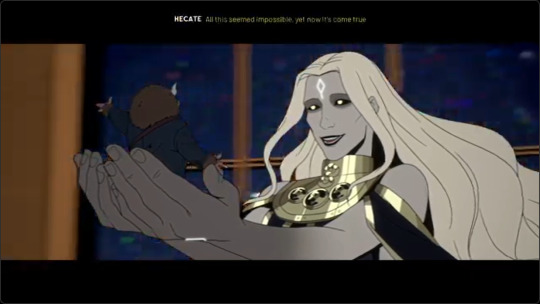
The reason why is simple. This is a metaphor for one of the main struggles of the rest of the cast. They are stuck in pomp and ceremony, in fantastical displays, in lies and deceptions, and here is a pair of characters who don't really care about that. Sure, Hecate is quirky and has the whole Dr Manhattan thing going on with her sense of time. But its deliberately simple to foil off the Olympians and their flaws.
And that's kind of what this song is doing. While everyone else is singing the same songs over and over again, Asterion makes a choice, sings something new, and gets consequences that are beneficial. Not all choices lead to death and sadness, sometimes you need to take a risk.
If you want to fix your life, you need to first get over yourself and start actually making choices.
Previous - Next
#rants#literary analysis#literature analysis#character analysis#greek mythology#stray gods#stray gods the musical#stray gods spoilers#stray gods the roleplaying musical#stray gods asterion#stray gods hecate
37 notes
·
View notes
Text
“From Anatolia and Iran, these [Indo-European] tribes continued to push southward into Mesopotamia and Canaan. According to Professor Albright,
There is both archaeological and documentary evidence pointing to a great migratory movement or movements from the northeast into Syria in the 18th century BC. As a result of this movement Hurrian and Indo-Iranian tribes flooded the country. By the 15th century we find most of eastern and northern Syria occupied predominantly by Hurrians and Indo-Iranians . . . Megiddo, Jerusalem and Ascalon [all in Canaan] are ruled by princes with Anatolian or Indo-Iranian names. The cranial type at Megiddo, which was previously Mediterranean in character, now becomes brachycephalic Alpine.
As the invasions were sporadic, they are difficult to follow and would probably require a volume on each particular area over a long period of time to be thoroughly explained. But historical, mythological and archaeological evidence suggests that it was these northern people who brought with them the concepts of light as good and dark as evil (very possibly the symbolism of their racial attitudes toward the darker people of the southern areas) and of a supreme male deity. The emergence of the male deity in their subsequent literature, which repeatedly described and explained his supremacy, and the extremely high position of their priestly caste may perhaps allow these invasions to be viewed as religious crusade wars as much as territorial conquests.
The arrival of the Indo-Aryan tribes, the presentation of their male deities as superior to the female deities of the indigenous populations of the lands they invaded and the subsequent intricate interlacing of the two theological concepts are recorded mythologically in each culture. It is in these myths that we witness the attitudes that led to the suppression of Goddess worship.
As Sheila Collins writes, "Theology is ultimately political. The way human communities deify the transcendent and determine the categories of good and evil have more to do with the power dynamics of the social systems which create the theologies than with the spontaneous revelation of truth from another quarter."
Judging from the production of religious mythology of the royal scribes and priests found in the archives of palaces of the Indo-European-ruled nations of the historic periods, often in the language of the conquered populations, we may surmise that political aims, rather than religious fervor, may well have been the motivation. The prevalence of myths that explain the creation of the universe by the male deity or the institution of kingship, when none had existed previously, strongly hints at the possibility that many of these myths were written by priests of the invading tribes to justify the supremacy of the new male deities and to justify the installation of a king as the result of the relationship of that king to the male deity.
The Indo-European male deity, unlike the son/lover of the Goddess religion, was most often portrayed as a storm god, high on a mountain, blazing with the light of fire or lightning. This recurrent symbolism suggests that these northern people may once have worshiped volcanoes as manifestations of their god, a factor I will discuss more thoroughly in Chapter Five. In some areas this god was annexed to the Goddess as a husband, such as the storm god Taru and the Sun Goddess of Arinna or Zeus and Hera. In some legends he emerged as a rebellious young man, who heroically destroyed the older female deity, at times upon the previously assured promise of supremacy in the divine hierarchy.
In many of these myths the female deity is symbolized as a serpent or dragon, most often associated with darkness and evil. At times the gender of the dragon seems to be neuter, or even a male (closely associated with his mother or wife who is the Goddess). But the plot and the underlying symbolic theme of the story is so similar in each myth that, judging from the stories that do use the name of the female deity, we may surmise that the allegorical identity of the dragon or serpent is that of the Goddess religion. The Goddess, the original supreme deity of the people conquered and ruled by the invading Indo-Europeans, was not ignored, but was symbolically included in such a manner that these supposedly religious myths allow us to trace Her eventual deposition.”
-Merlin Stone, When God Was a Woman
#Merlin stone#goddess culture#goddess religion#patriarchal religion#serpent symbolism#human history#indo european
22 notes
·
View notes
Text
Vandal Savage
Vandal Savage (born circa 50,000 BC) is a metahuman, immortal, warlord and conqueror who has been active under numerous aliases in numerous places. Savage was born Vandar Adg, a member of the Blood Tribe in Anatolia well before the Hyborian Age. Adg’s acquisition of immortality is somewhat shrouded in rumor, but most available information implies the alien race known as the Scrin signaled their presence via a meteor shower and granted Adg a regenerative form of immortality in return for alliance with them. Adg was also given superhuman strength and psychic insight into others, making him functionally a genius. Adg used this power to aid his tribe in a revolt against the Children of the Night, a hairy ape-like race that dominated much of the world outside of Europe in this era. Adg’s genius and powers made him a formidable fighter against the Children. After helping defeat the Children, Adg would wander the Middle East and southern Europe for millennia, somewhat aimless for a while. He fought with the Immortal and at one time attempted to overthrow the Sumerian king Gilgamesh. Eventually, Adg’s ambitions grew and he constructed his first falsified identity in the form of Alexander the Great. In this identity, Adg was not wholly malevolent–he saved the realm of Pentexore from the giants Gog and Magog, established institutions like the Library of Alexandria and the First Warehouse, and briefly met the god Apollo, for instance–but displayed a ruthless, brutal side. During his conquests as Alexander, Adg briefly attempted to fight his way through Hell and was told he would one day end the world. When he got to India, Adg defeated an undead army of those he had previously slain and displayed a willingness to end the world, though this would ultimately not come to pass. Adg’s forces drew the attention of a race of aliens seeking to eliminate mankind, who copied Adg and his army to a parallel world as a record. In the end, Adg’s reign as Alexander ended with a poisoning attempt by the precursors of the Assassins, who were upset at his use of Precursor technology in his conquests.
Adg, however, was not to be kept down permanently via this method. Upon recovering, Adg once again sought to embark on conquest and domination. However, he would come to encounter a number of rivals to his power. Immortal Man, the Immortal, Hawkman, Hawkgirl and Ra’s Al Ghul were just a few of his long-running rivals. The Time Lord known as Professor Omega would regularly sabotage Adg’s efforts. The body-jumping being known as Doro became an enemy of Savage due to viewing him as a potential threat, a belief shared by Ayesha, the Queen of Kor. The time-traveling conqueror known as Kang likewise opposed Adg, viewing him as a threat. Despite these rivals, however, Adg was able to continue to assert himself. One of his most successful regimes was under the fabricated identity of Julius Caesar. As Caesar, Adg had multiple lovers including Egypt’s Cleopatra and the legendary warrior Xena, was targeted for murder by a time traveler and conquered most of Gaul outside the village of Amorica. Ultimately, Adg’s rule would collapse when he was stabbed multiple times by several members of the Roman Senate led by Brutus and Cassius-an attack which nearly actually killed Adg, a fact which caused him to go into hiding for centuries. Adg would reemerge in the 13th century as the Mongolian warlord Genghis Khan. After absorbing the remnants of the horde of Shan Yu (a notorious torture-happy Hun warlord who was killed by the warrior Fa Mulan) embarked on a conquest spree. Adg as Khan managed to establish what was at the time the world’s largest empire by land area and had numerous conquest-happy descendants including Khotun Khan, Shiwan Khan, and the Golden Claw. After being nearly killed by the Assassins, Adg went into a subtler form of operating.
Adg ultimately tired of operating in the shadows by the 1600’s, however. In this era, piracy was increasingly prevalent and here Adg saw his chance to once again become a feared warrior. Adg crafted the identity of Edward Teach and became a pirate, operating under the name of Blackbeard. In this identity, Adg would mentor several other pirates including Anne Providence and Connor Kenway, enter a relationship with Stede Bonnet the so-called ‘gentleman pirate’ and bury large amounts of treasure. Adg’s actions in this identity helped lead to him adopting his modern name of Vandal Savage and inspired a number of imitators, including one who would seemingly die in a confrontation with the Royal Navy only to be resurrected with dark magic. Savage’s nautical exploits would end with the Brethren Court’s unleashing of the goddess Calypso, which ushered in an event later dubbed the Alteration which made the seas deeply unsafe. Savage took refuge in Europe and resumed a role as a manipulator in the shadows. Operating behind the scenes, Savage influenced the likes of Napoleon Bonaparte and Otto Von Bludiron in the 19th century and in the 20th would be among the many vying to influence German Fuhrer Adenoid Hynkel. However, facing challenges from Hydra, Savage ultimately betrayed Hynkel and formed a common cause with communist forces in Eastern Europe, becoming a close confidant of Pottsylvanian dictator Josef Besstrashny.
The latter part of the 20th century saw Savage become more widely known as a supervillain. Savage would clash with the likes of the Justice League and Avengers on numerous occasions. Savage faced recurring failure, however, to secure what he really wanted. In an era where the likes of Victor Von Doom, Vega (also known as M. Bison), and Khan Noonien Singh managed to assert direct rule, Savage was full of envy. Savage was not content to stew in bitterness, however. Taking advantage of his latent-and secret-psychic abilities, Savage carefully constructed the identity of the enigmatic Kane and formed the organization known as the Brotherhood of Nod. Nod’s moment to threaten the world would come in the mid-1990’s with the arrival of the element Tiberium to Earth. Savage, on the advice of his ancient benefactors the Scrin, worked to secure the resource, viewing it as essential to his goal of conquest. However, the world refused to surrender. The formation of the Global Defense Initiative in 1996 helped contain Nod even amidst the turmoil of the Harvester and Fithp invasions. By 2000, a frustrated Savage retreated into hiding. Even the chaos of the early 21st century did not see Savage reemerge. It was only in the 2040’s-amidst worldwide turmoil-that Savage made another attempt at conquest. Savage emerged in this era in the identity of the so-called Grandmaster Meio and experienced much early success in conquering the world. However, in doing so, Savage ran afoul of the megacorporate institutions growing increasingly dominant over the world. Led by the Genom Corporation, they dedicated intense resources to imprisoning Savage. Ultimately, a chamber designed by the Vandein Corporation was deployed and Savage was lured into it. The trap was successful and Savage would be imprisoned for centuries.
Upon emerging, Savage had somewhat mellowed out and foreswore further conquest. He adopted the name Mr. Flint and attempted to live in peace for hundreds of years. Eventually, though, the constant attacks on Earth by aliens and dysfunctional Earth government led Savage to in the 3020’s launch a bid to seize control of the planet. The Earth government at the time, the United States of Earth, was a decrepit body led by the no-longer-sane resurrected head of Richard Monckton, whose blatant corruption and incompetence left the planet quite vulnerable. Savage’s attempt to seize control in a coup was derailed, however, by the simultaneous effort of Nathaniel Richards. Richards, who would in later time be better known as Kang the Conqueror, was a figure that Savage was vaguely aware of, but was not aware of his native time, which meant Kang (who had been in communication with versions of himself from other times) had the advantage. Kang’s forces were able to overthrow the USE and imprison Savage, but soon ran into further challenges. Neo-Queen Serenity, who had been ruling Japan for centuries already from Crystal Tokyo, challenged Kang’s rule of the planet, aided by the Legion of Superheroes, Savage, meanwhile, gave both sides the slip and escaped the planet. Enraged at being denied what he considered his right, Savage directed the Drej and Glorft fleets towards Earth, hoping that alien attacks would weaken both Serenity and Kang enough for him to take over the planet. Unfortunately for Savage, the Drej fleet was successfully repelled with ease and while the Glorft posed a much greater threat, the ultimate victory of Serenity’s Silver Millennium meant in the end the planet remained intact.
Savage spent much of his time in the early years beyond Earth biding his time. The emergence of the first galactic empire of humankind sparked Savage’s interest. Afterwards, Savage used his psychic capabilities to carve out a fiefdom under the pseudonym of ‘the Mule.’ In this guise, he sought to conquer the galaxy but was thwarted by Hari Seldon’s Foundation. Savage, undeterred, worked his way into the good graces of House Corrino of Salusa Secundus. Savage encouraged them to go beyond ruling a handful of star systems by waging war against rivals such as the Ekumen and the Star Kingdom of Manticore. Savage’s guidance led to the formation of a second empire, but Savage’s influence would be sidelined when Paul Atriedes overthrew the Corrinos with the help of the Fremen of Arrakis and his son Leto II scattered humankind. It was at this time Savage rediscovered Earth-a badly battered shell of its former self, still not having recovered from a war between Tsan-Chan and Panem that had occurred nearly 20,000 years earlier. Toons and Moureau sapiens who dubbed the planet Mobius dominated the place. Savage would seize the planet relatively easily, purging the nonhumans as well as the remnant Methusalahs who tried to supplant him at the last minute and from there proclaimed the formation of the Imperium of Man. Savage declared himself the Emperor of Mankind and began conquering the human worlds throughout the galaxy. Savage sought to bring benevolent tyranny to his subjects, but on being rendered comatose, his empire warped. Savage became hailed as a God-Emperor and his Imperium entered an era of dark, disastrous warfare. It is unclear whether Savage could end this if he woke up or if he would embrace what the Imperium has become either out of hubris or necessity, but for now his Imperium worships his comatose form while waging total war on a number of rival factions..
References:
DC Comics, Conan the Barbarian, Command and Conquer, SCP Foundation, Invincible, The Epic of Gilgamesh, Dirge for Prester John, Warehouse 13, Alexander (1925 film), Dante’s Inferno (video game), Reign: The Conqueror, A Time Odyssey, Assassin’s Creed, Doctor Who, Professor Omega, Wild Seed, She, Xena: Warrior Princess, Criminal Case: Travel in Time, Asterix, Julius Caesar, Firefly, Mulan, Ghost of Tsushima, The Shadow, Marvel Comics (Agents of Atlas, The Avengers), Anne of the Indies, Our Flag Means Death, On Stranger Tides, Pirates of the Caribbean, Sense and Sensibility and Sea Monsters, Meccania the Super-State, The Great Dictator, Rocky and Bullwinkle, Mortal Kombat, Star Trek, Independence Day, Footfall, Strider, Bubblegum Crisis, Magical Record Lyrical Nanoha Force, Futurama, The Company, Sailor Moon, Titan AE, Megas XLR, Foundation, Dune, Hainish Cycle, Honor Harrington, Cthulhu Mythos, The Hunger Games, Who Framed Roger Rabbit?, The Island of Doctor Moureau, Sonic the Hedgehog, Trinity Blood, Warhammer 40K

#mega crossover#league of extraordinary gentlemen#dc comics#vandal savage#warhammer 40k#alexander the great#alternate history#alternate universe
6 notes
·
View notes
Note
Have you watched films by nuri bilge ceylan
Noo but I really want to, his film “Once Upon a Time in Anatolia” has been on my watchlist for ages 🤦🏻♂️
Will try to watch it soon tho!!
(thanks for reminding me about him, want to suggest you some great filmmakers too if you're into cinema; Abbas Kiarostami, Wong Kar Wai, Vikramaditya Motwane)
Hope you're having a good dayy 🌻💫
9 notes
·
View notes
Text
Legendary Warrior Women of the Ancient World
Once upon a time, there were women who challenged the might of empires and the laws of men.
They beckoned a world where the whisper of a woman's voice could quake the thrones of tyrants.
Let's delve into these legends from antiquity. 🧵⤵️
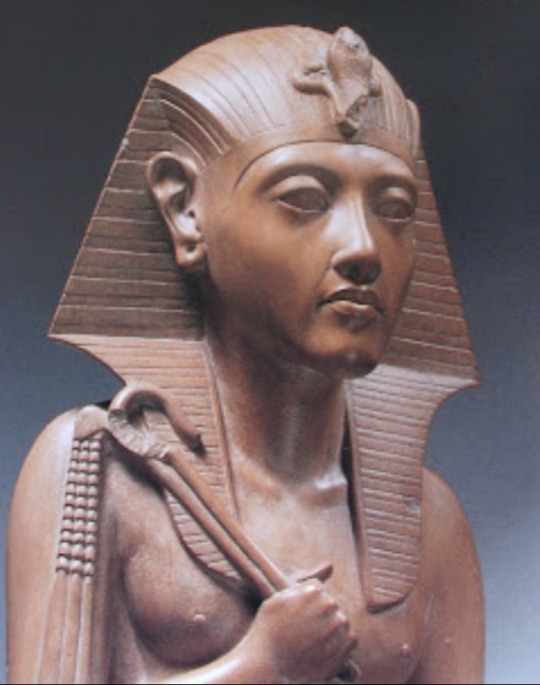
Hatshepsut
The fifth pharaoh of the Eighteenth Dynasty of Egypt, Hatshepsut reigned longer than any other woman of an indigenous Egyptian dynasty.
She was one of the most prolific builders in Ancient Egypt.
To legitimize her reign, Hatshepsut claimed she was divinely conceived by the god Amun, who appeared to her mother in the guise of the pharaoh Thutmose I, her father.
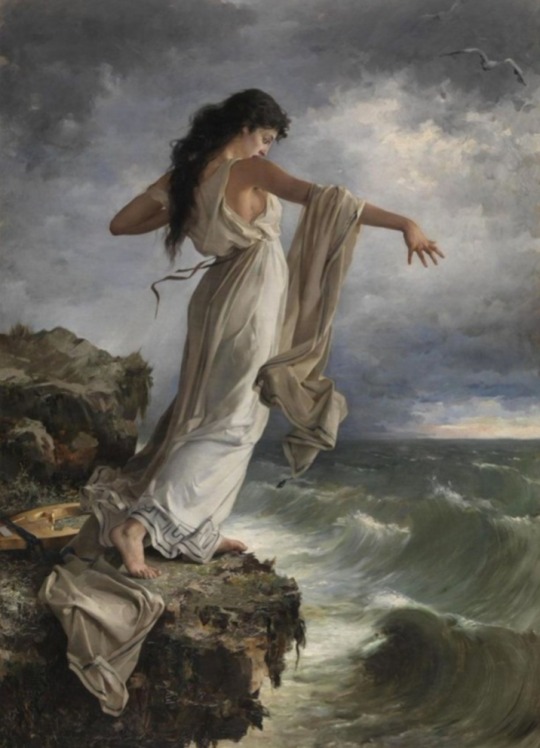
Sappho
An ancient Greek poet from the island of Lesbos, Sappho is celebrated for her lyric poetry, which explores love and passion.
Legend says that Sappho leaped from the Leucadian cliffs due to her unrequited love for Phaon, a ferryman, demonstrating the depth of her emotional expressions that permeated her work.

Artemisia I of Caria
A queen of the ancient Greek city-state of Caria and an ally of Xerxes I during the Second Persian invasion of Greece.
In the Battle of Salamis, Artemisia was so cunning in combat that she intentionally rammed her ally's ship to escape the Greeks, convincing them she was an ally and thus avoiding capture.

Hypatia
A mathematician, astronomer and philosopher in Alexandria, Egypt, Hypatia was a renowned teacher and thinker.
Hypatia was known to drive through Alexandria in her chariot to deliver public lectures on philosophy, defying the gender expectations of her time.
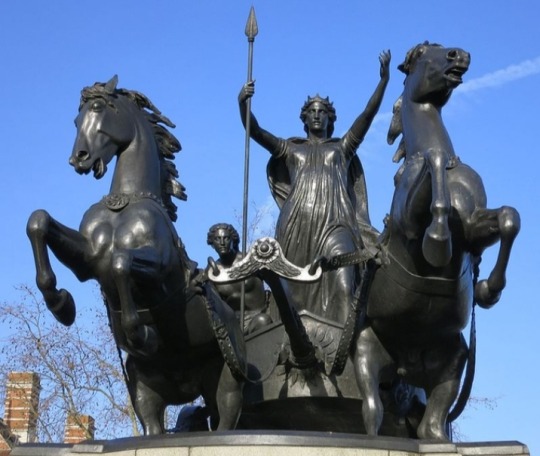
Boudicca
The warrior queen of the Iceni tribe who led a major uprising against the occupying forces of the Roman Empire in Britain.
After the Romans flogged Boudicca and raped her daughters, she rallied her tribe and neighboring tribes for revenge, resulting in the destruction of Roman settlements and the decimation of the Roman Ninth Legion.
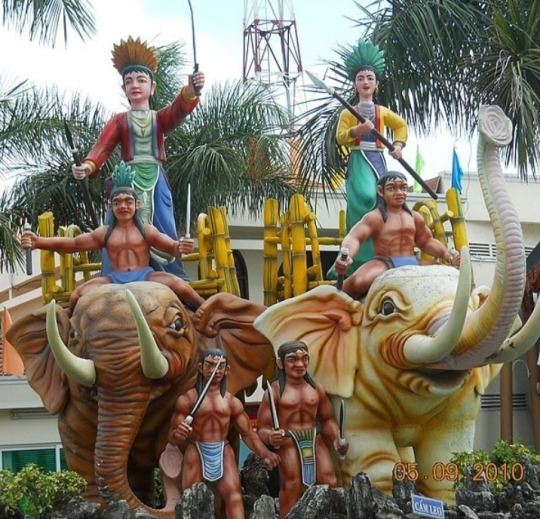
The Trung Sisters: Trung Trac and Trung Nhi
Vietnamese military leaders who rebelled against Chinese Han dynasty rule, becoming enduring symbols of resistance.
The sisters, after witnessing the suffering of their people under Chinese rule, famously declared their independence by proclaiming:
"All the male heroes bowed their heads in submission; only the two sisters proudly stood up to avenge the country."

Khawlah bint al-Azwar
A legendary female Muslim warrior, she fought alongside the early Muslims in the battles against the Byzantine Empire.
Khawlah famously donned male warrior’s armor to rescue her brother from a Byzantine prison camp, charging into battle with such ferocity that opponents assumed she was a supernatural entity.

Joan of Arc
A French heroine and saint of the Catholic Church, Joan led French forces to victory over the English at Orléans.
Joan persuaded a skeptical Charles VII of France of her divine mission to save France by correctly predicting a military reversal at the Siege of Orleans, before any messenger could have reached them with the news.

Zenobia
The third-century queen of the Palmyrene Empire in Syria who challenged the authority of the Roman Empire.
Zenobia was so bold that she claimed descent from Cleopatra, positioning herself as the Egyptian queen's successor in defiance of Rome and marched her armies as far as Egypt and Anatolia.
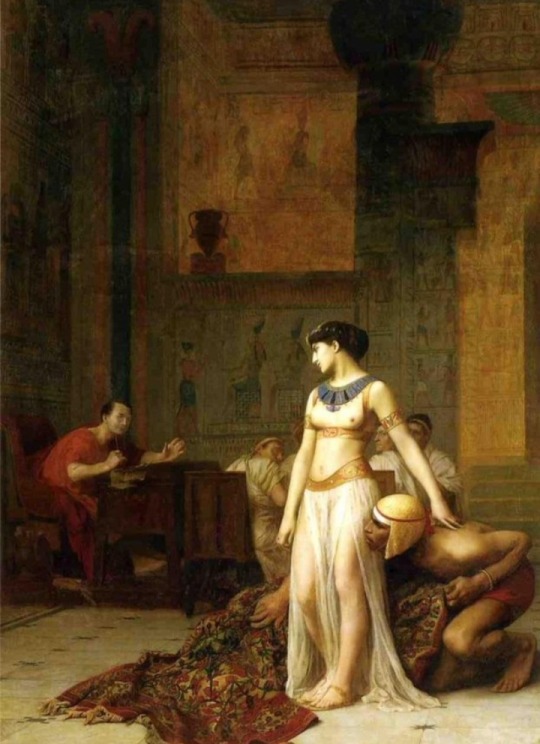
Cleopatra VII
The last active ruler of the Ptolemaic Kingdom of Egypt, Cleopatra is known for her intelligence, political acumen, and dramatic love affairs.
In a famous encounter to secure her alliance with Julius Caesar, Cleopatra had herself wrapped in a carpet (or linen sack, according to some accounts) and delivered to him, emerging to charm Caesar with her wit and beauty.
#female warriors#ancient civilizations#legendary warriors#Hatshepsut#Amun#Thutmose I#Sappho#Phaon#Artemisia I of Caria#Xerxes I#Hypatia#Boudicca#The Trung Sisters: Trung Trac and Trung Nhi#Khawlah bint al-Azwar#Joan of Arc#Charles VII of France#Zenobia#Cleopatra VII#Julius Caesar#ancient empires#ancient world#legends
5 notes
·
View notes